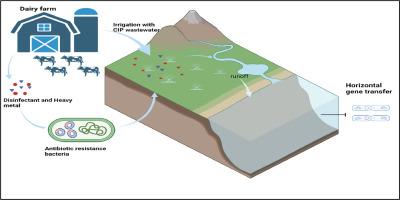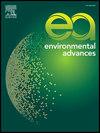The potential ecological risk of co and cross-selection resistance between disinfectant and antibiotic in dairy farms
Q2 Environmental Science
引用次数: 0
Abstract
The surge in antibiotic use in various industries has led to increased excretion of antibiotic resistance genes (ARG) to the environment, this poses threat to human and animal health. The dairy industry particularly dairy farms have been identified as one of the large contributors of antibiotic resistant bacteria (ARB) and ARG in the environment. The unregulated use of antibiotics and the use of disinfectants in the clean in place (CIP) process and heavy metal used for animal feed has been said to result in the induction of antibiotic resistance genes in pathogenic bacteria present in dairy wastewater (DWW). Disinfectant and heavy metals induce antibiotic resistance by inducing efflux pump genes which induce co-selection and cross-selection. There are several studies reporting cross and co-selection between heavy metals, disinfectants such as H2O2 and antibiotics which induce ciprofloxacin and ampicillin resistance in Staphylococcus aureus, while Zn resistance genes(czrC) and methicillin resistance gene (mecA) select for Methicillin-resistant Staphylococcus aureus (MRSA). Controlling the spread of antimicrobial resistance in the environment requires a thorough understanding of their causes. Hence, this review aims to provide an overview of the role chemical materials present in DWW such as CIP chemicals, heavy metals in induction of antibiotic resistance through co- and cross-selection. Additionally, and their mechanism of co- and cross-selection resistance, their pathway to the environment and preventative measures are also discussed.

奶牛场中消毒剂和抗生素之间的共同抗药性和交叉选择抗药性的潜在生态风险
随着各行各业抗生素使用量的激增,环境中抗生素耐药基因(ARG)的排泄量也随之增加,这对人类和动物的健康构成了威胁。乳制品行业,尤其是奶牛场,已被确定为环境中抗生素耐药菌(ARB)和抗生素耐药基因(ARG)的主要来源之一。据说,抗生素的无节制使用、就地清洁(CIP)工艺中消毒剂的使用以及动物饲料中重金属的使用,都会导致奶制品废水(DWW)中的病原菌产生抗生素耐药基因。消毒剂和重金属通过诱导外排泵基因来诱导抗生素耐药性,而外排泵基因会诱导共同选择和交叉选择。一些研究报告称,重金属、消毒剂(如 H2O2)和抗生素之间的交叉选择和共选择诱导了金黄色葡萄球菌对环丙沙星和氨苄西林的耐药性,而锌耐药基因(czrC)和甲氧西林耐药基因(mecA)则选择了耐甲氧西林金黄色葡萄球菌(MRSA)。要控制抗菌素耐药性在环境中的传播,就必须彻底了解其成因。因此,本综述旨在概述存在于 DWW 中的化学物质(如 CIP 化学品、重金属)在通过共选择和交叉选择诱导抗生素耐药性方面的作用。此外,还讨论了它们产生共同和交叉选择耐药性的机制、进入环境的途径以及预防措施。
本文章由计算机程序翻译,如有差异,请以英文原文为准。
求助全文
约1分钟内获得全文
求助全文
来源期刊

Environmental Advances
Environmental Science-Environmental Science (miscellaneous)
CiteScore
7.30
自引率
0.00%
发文量
165
审稿时长
12 weeks
 求助内容:
求助内容: 应助结果提醒方式:
应助结果提醒方式:


